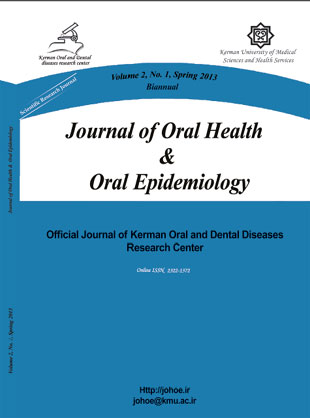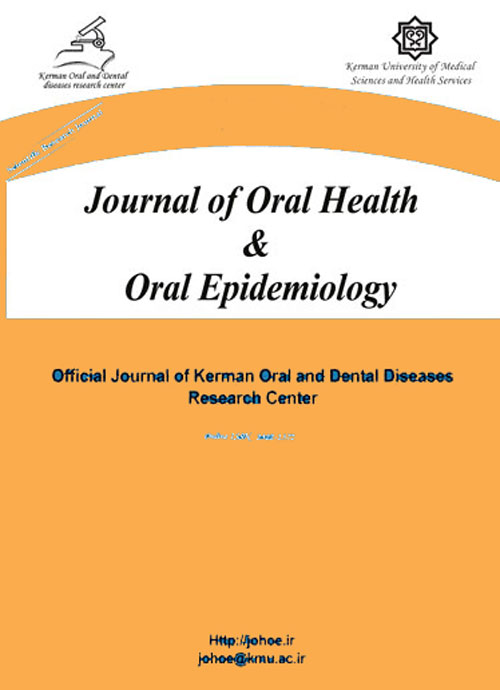فهرست مطالب

Journal of Oral Health and Oral Epidemiology
Volume:2 Issue: 1, Winter-Spring 2013
- تاریخ انتشار: 1392/03/16
- تعداد عناوین: 8
-
-
Pages 1-5BackgroundIncreased dental caries and dental lesions have made preventive measures, especially among children, inevitable. This study investigated elementary schoolgirls’ mothers’ level of knowledge on preventive methods against dental caries.MethodsIn this cross-sectional study, mothers of 250 schoolgirls were randomly selected from five regions of Tehran, Iran. Their knowledge about fissure sealant therapy and fluoride therapy was evaluated using a questionnaire. Data was analyzed by analysis of variance and independent t-tests in SPSS.ResultsMothers’ knowledge about fissure sealant therapy was lower than fluoride therapy. Very low, low, and moderate levels of knowledge were detected among nearly a quarter, 47.5%, and 22.6% of the participants, respectively. Only 5.4% of the subjects had acceptable level of knowledge on preventive dentistry methods. There were significant correlations between mothers'' level of knowledge and their education level and occupational status.ConclusionEducated mothers and working mothers had greater knowledge than did housewives. Dentists have a crucial role in increasing mothers'' knowledge.Keywords: Pit, Fissure Sealant Therapy, Knowledge, Fluoride Therapy
-
Pages 6-12Background And AimThe aim of this study was to evaluate the prevalence and severity of oral impact on daily performance (OIDP) in adults attending dental clinics in the city of Kerman, Iran.MethodsIn 2010, a cross-sectional survey was conducted on a sample of 400 patients (age 20-50 years) referring to dental centers in Kerman. Validated OIDP inventory was used to collect data. Clinical examination was also carried out by a trained interviewer. Analysis of variance (ANOVA) and Student’s t-test were used for statistical analysis.ResultsOral and dental diseases affected at least one daily activity of all participants (100%) during the six months prior to the study. The mean OIDP score of the subjects was 19% ± 12%. The most common affected activity was eating (92.6%). The most prevalently reported oral problem was dental caries (65.3%). Subjects who had better dental hygiene (tooth brushing and flossing habits) were more likely to have lower OIDP score (P = 0.001 for brushing; P = 0.002 for flossing).ConclusionThe results of the study showed that people who attended dental clinics had at least one oral/dental problem that effected their daily performance. Since the prevalence of OIDP was very high, providing more dental care and services is required.Keywords: Oral Impact on Daily Performance, Oral Health, Related Quality of Life, Oral Health, Adult, Cross, Sectional Studies
-
Pages 13-17Background And AimBacterial plaque is a biofilm which is related to its host and its exact role is proved in caries and periodontal disease. These days people brush their teeth and use mouthwash. In this research the effect of Jaman solution (Hezar Co., Iran) was compared with Biotene mouth rinse in an in-vitro study.MethodsBiotene mouth rinse (Laclede Co., US) contains 4 antibacterial enzymes. Four different bacteria such as Streptococcus (S.) salivarius, S.sobrinus, S.sanguis and Actinomyces viscosus were cultured in the lab. The effects of Jaman, Biotene and penicillin on these bacteria were tested by using disc diffusion method.ResultsThe antibacterial effects of Jaman and Biotene did not show any significant differences. Both of Jaman and Biotene showed significant differences with blank disc and penicillin.ConclusionsAccording to the results, the antibacterial effect of Biotene is not better than Jaman.Keywords: Biotene, Jaman, Mouth Rinse, Streptococcus, Actinomyces
-
Pages 18-22Background And AimThe purpose of this study was to determine the prevalence of finger sucking habit among three-six-year-old children from kindergartens of Kerman, Iran.MethodsThis descriptive, cross-sectional study used census sampling to select 1000 children from 40 kindergartens. Data was collected by a checklist and clinical examination. Chi-square test in SPSS16 wasused for statistical analysis.ResultsThe prevalence of finger sucking habit was 3.4%. There was no statistically significant relation between gender and the habit. Pacifier sucking habit was not an influencing factor in finger sucking habit. Most children (47.06%) had received exclusive breastfeeding. Anterior open bite was seen in 50.00% of the children with finger sucking habit.ConclusionThis study showed the decreased prevalence of finger sucking habit compared to similar studies. This difference might have been caused by the type of feeding (about 50% of the children in the present study were breast-fed).Keywords: Finger, Thumb Sucking, Prevalence, Oral Habits, Breast, Feeding
-
Pages 23-27Background And AimNeedlestick (NS) injuries are one of the most important subjects in the dental field which can cause so many dangerous blood-borne diseases. The aim of this study was to evaluate the prevalence, knowledge, and practice of dentists and their assistants about exposure to sharp contaminated instruments in Kerman, Iran, in 2012.MethodsIn this cross-sectional study, self-administered questionnaires were distributed among 190 dentists and 250 assistants. Data were analyzed by chi-square and 2-sample tests.Results32% of dentists and 30.7% of assistants had experienced NS injury. The mean scores of knowledge and practice in dentists were 4.88 ± 1.69 and 3.37 ± 0.70 from the maximum scores of 10 and 4. There was only a significant correlation between knowledge score and gender (P = 0.02), and a near significant correlation between practice and gender (P = 0.06) (male > female). However, they had no correlation with age, length of professional experience, and educational degree. In assistants, the mean score of practice was 2.84 ± 0.67 from the maximum score of 5. Furthermore, 96.6% of dentists and 76.3% of assistants had been vaccinated against hepatitis B.ConclusionsThe obtained results show that the practice level of dentist in NS injury prevention and management is good but their knowledge and also their assistants’ practice is undesirable. The level of knowledge and practice was the same for general and specialist dentists. It seems that specialist dentists cooperate better in vaccination and measuring of anti-HBs antibody titre.Keywords: Needlestick, Dentist, Knowledge, Practice, Hepatitis, Infection Control, Assistants, Prevalence
-
Pages 28-34Background And AimThe effects of xerostomia on oral health have been studied for decades; however, the prevalence of this disorder in the general population remains controversial. The purpose of this study was to determine the prevalence of xerostomia in the population of Kerman, Iran.MethodsA total of 1010 subjects participated in this cross-sectional study. Study volunteers completed a standardized questionnaire regarding demographic data, history of systemic disease, use of medication, cigarette smoking, and etcetera. The Fox questionnaire was also completed to diagnose xerostomia.ResultsThe prevalence of xerostomia in this study was 55% (59.9% among men and 49.9% among women). The mean age of the study population was 34.7 ± 12.1. 21.5% of cases had a systemic disease and 19% reported taking medication. Moreover, 25.9% of the participants (30% men and 4.6% women) smoked cigarettes or other tobacco products. Systemic disease, medication, and the use of tobacco products and opiates were found to be significant risk factors for xerostomia.ConclusionThe prevalence of xerostomia in our study was higher than that reported in other populations. Smoking and medication were significant risk factors for xerostomia.Keywords: Epidemiology, Prevalence, Xerostomia, Dry Mouth
-
Pages 35-43Background And AimEstimation of need and demand for orthodontic treatment is important for both health professionals and health policymakers. Need assessment is traditionally done using experts’ opinions; however, patient-centered evaluation can provide a bigger picture of patient’s esthetic and psychological needs. The willingness to pay (WTP) technique is a potentially valid tool for assessing the patient views on their needs and for market research in healthcare. The aim of this study was to evaluate the need and demand for orthodontic treatment with a patient-centered approach using economic analysis.MethodsA cross-sectional study was designed. Two hundred people attending Shiraz Dental School Clinic were interviewed. Their views on the importance and costs of orthodontic treatments and the maximum amount that they would pay for such treatments were obtained along with their demographic and socioeconomic factors. Their WTP was used to elicit values for orthodontic treatment using contingent valuation method (CVM) and econometric techniques.ResultsThe response rate was 95%. Although 53.5% of respondents felt they needed orthodontic treatment, only 33.7% had expressed their need, and just 17.5% had actually gone for such treatment. The main reason for not taking the treatment was its cost (56.5%). More than 60% of respondents viewed orthodontics as only a luxury treatment and 70% considered beauty and elegant smile as the most, or one of the most, benefit(s) of orthodontic treatments. WTP results showed that orthodontic services have high demand elasticity. Assuming fixed monthly income of 8 million Rials, 61% of subjects were ready to pay 20 million Rials for a course of orthodontic treatment.ConclusionThe result showed that esthetics and high cost of treatment were respectively the most intriguing and the main inhibiting factors for getting orthodontic treatment. Economic evaluation showed a high elastic estimation for orthodontic treatment.Keywords: Willingness to Pay, Orthodontics, Shiraz
-
Pages 44-48Background And AimThe number of patients who need prosthetic treatments has increased. Efficient and regular procedures for cleaning removable dentures are important for maintaining good oral health. The aim of this study was to analyze the oral and prostheses care habits of removable denture users, who attended the clinics of Kerman, Iran.MethodsThis cross-sectional study was carried out on 350 patients, who attended the clinics of Kerman and were chosen by the multistage sampling method. Data were obtained from a checklist consisting of demographic characteristics (age, sex, educational level, kind of prosthesis, age of prosthesis, self-report of halitosis, and smoking status), denture hygiene habits, denture-wearing behavior, and cleanliness of denture by examiner. Data was analyzed using chi-squared test (P < 0.05).ResultsThe mean age of patients was 58.52 ± 10.78 years, 103 (29.4%) were male and 247 (70.6%) were female. The results showed that 78.6% had complete denture and 12.7% reported halitosis, 55.1% used their denture at night, and 36.4% had poor denture hygiene. Brushing was the most used cleaning method by the patients (36.5%). 60.4% reported never having been instructed by their dentists as to how to clean their dentures. 58.6% had been using the same denture for more than 5 years. There was a significant correlation between the kind of denture, and denture hygiene and education level.ConclusionAccording to the results of the present study denture hygiene was not favorable. Therefore, dentists should instruct the patients on cleaning their denture in order to prevent denture–induced lesions.Keywords: Complete Denture, Removable Denture, Habits, Hygiene, Dental Care


